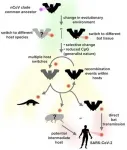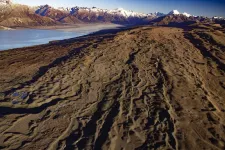Glaciers and enigmatic stone stripes in the Ethiopian highlands
2021-03-12
(Press-News.org) As the driver of global atmospheric and ocean circulation, the tropics play a central role in understanding past and future climate change. Both global climate simulations and worldwide ocean temperature reconstructions indicate that the cooling in the tropics during the last cold period, which began about 115,000 years ago, was much weaker than in the temperate zone and the polar regions. The extent to which this general statement also applies to the tropical high mountains of Eastern Africa and elsewhere is, however, doubted on the basis of palaeoclimatic, geological and ecological studies at high elevations.
A research team led by Alexander Groos, Heinz Veit (both from the Institute of Geography) and Naki Akçar (Institute of Geological Sciences) at the University of Bern, in collaboration with colleagues from ETH Zurich, the University of Marburg and the University of Ankara, used the Ethiopian Highlands as a test site to investigate the extent and impact of regional cooling on tropical mountains during the last glacial period. The results have been published in the scientific journals Science Advances and Earth Surface Dynamics.
Formation of plateau and valley glaciers
"The Ethiopian Highlands are currently not covered by ice, despite its elevation of over 4,000 m," explains Groos, who studied the glacial, climatic and landscape history of the Bale and Arsi Mountains in the southern highlands as part of his dissertation. "Moraines and other land forms, however, attest to the fact that these mountains were glaciated during the last cold period," he continues.
Moraine boulders in the Bale and Arsi Mountains were mapped and sampled in the field and later dated using the chlorine isotope "36Cl" to accurately determine the extent and timing of past glaciations. The researchers were in for a surprise: "Our results show that glaciers in the southern Ethiopian Highlands reached their maximum extent between 40,000 and 30,000 years ago," says Groos, "several thousand years earlier than in other mountainous regions in Eastern Africa and worldwide." In total, the glaciers in the southern highlands covered an area of more than 350 km² during their maximum. In addition to the cooling of at least 4 to 6 °C, the extensive volcanic plateaus above 4,000 m favored the development of glaciation in this magnitude.
The researchers gained important insights by comparing the specially reconstructed glacier fluctuations in the Ethiopian Highlands with those of the highest East African mountains and climate archives from the Great African Rift Valley. "The cross-comparisons show that the tropical mountains in Eastern Africa have experienced a more pronounced cooling than the surrounding lowlands," Groos concludes. "Furthermore, the results suggest a nonuniform response by East African glaciers and ice caps to climate changes during the last cold period, which can be attributed to regional differences in precipitation distribution and mountain relief, among other factors," he continues.
The enigma of the stone stripes
During their fieldwork on the central Sanetti Plateau in the Bale Mountains, the researchers also came across gigantic stone stripes (up to 1,000 m long, 15 m wide and 2 m deep) outside the area of the former ice cap. "The existence of these stone stripes on a tropical plateau surprised us, as so-called periglacial landforms of this magnitude were previously only known from the temperate zone and polar regions and are associated with ground temperatures around freezing point," Groos said. However, the average ground temperature on the Sanetti Plateau is currently about 11 °C.
The large boulders and basalt columns that make up the stone stripes originally came from heavily eroded rock formations and volcanic plugs. As things stand, the researchers assume that the stone stripes were formed during the last glacial period through natural sorting of the previously chaotically distributed rocks in the course of the periodic freezing and thawing of the ground near the former ice cap. However, locally this would have required a drop in the mean ground temperature of at least 11 °C and in the mean air temperature of at least 7 °C. Whether this unprecedented cooling is a regional phenomenon or exemplary for the cooling of tropical high mountains during the last glacial period must be shown by future studies from other tropical mountain regions.
INFORMATION:
[Attachments] See images for this press release:

ELSE PRESS RELEASES FROM THIS DATE:
2021-03-12
How much did SARS-CoV-2 need to change in order to adapt to its new human host? In a research article published in the open access journal PLOS Biology Oscar MacLean, Spyros Lytras at the University of Glasgow, and colleagues, show that since December 2019 and for the first 11 months of the SARS-CoV-2 pandemic there has been very little 'important' genetic change observed in the hundreds of thousands of sequenced virus genomes.
The study is a collaboration between researchers in the UK, US and Belgium. The lead authors Prof David L Robertson (at the MRC-University of Glasgow Centre for Virus Research, Scotland) ...
2021-03-12
Informing how COVID-19 response plans may incorporate digital contact tracing, a model of COVID-19 spread within a simulated French population found that if about 20% of the population adopted a contact tracing app on their smartphones, an outbreak could be reduced by about 35%. If more than 30% of the population adopted the app, the epidemic could be suppressed to manageable levels. Jesús Moreno López and colleagues note that the effectiveness of digital contact tracing would depend on a given population's level of immunity to the virus; the intervention alone would be unable to suppress a COVID-19 epidemic where transmission - and especially asymptomatic transmission - remains high. While many countries have implemented ...
2021-03-12
DURHAM, N.C. -- If you binged on high-calorie snacks and then spent the winter crashed on the couch in a months-long food coma, you'd likely wake up worse for wear. Unless you happen to be a fat-tailed dwarf lemur.
This squirrel-sized primate lives in the forests of Madagascar, where it spends up to seven months each year mostly motionless and chilling, using the minimum energy necessary to withstand the winter. While zonked, it lives off of fat stored in its tail.
Animals that hibernate in the wild rarely do so in zoos and sanctuaries, with their climate controls and ...
2021-03-12
Decades of feminist gains in the workforce have been undermined by the COVID-19 pandemic, which has upended public education across the United States, a critical infrastructure of care that parents -- especially mothers -- depend on to work, according to new research from Washington University in St. Louis.
The research, published in Gender & Society, draws on new data from the Elementary School Operating Status (ESOS) database to show that the gender gap between mothers and fathers in the labor force has grown significantly since the onset of the pandemic in states where schools primarily offered remote instruction.
And if these circumstances continue, it could deliver ...
2021-03-12
Sound sleep plays a critical role in healing traumatic brain injury, a new study of military veterans suggests.
The study, published in the Journal of Neurotrauma, used a new technique involving magnetic resonance imaging developed at Oregon Health & Science University. Researchers used MRI to evaluate the enlargement of perivascular spaces that surround blood vessels in the brain. Enlargement of these spaces occurs in aging and is associated with the development of dementia.
Among veterans in the study, those who slept poorly had more evidence of these enlarged spaces and more post-concussive symptoms.
"This has huge implications for the armed forces as well as civilians," said lead author Juan Piantino, M.D., MCR, assistant professor of pediatrics (neurology) in the ...
2021-03-12
Astronomers have painted their best picture yet of an RV Tauri variable, a rare type of stellar binary where two stars - one approaching the end of its life - orbit within a sprawling disk of dust. Their 130-year dataset spans the widest range of light yet collected for one of these systems, from radio to X-rays.
"There are only about 300 known RV Tauri variables in the Milky Way galaxy," said Laura Vega, a recent doctoral recipient at Vanderbilt University in Nashville, Tennessee. "We focused our study on the second brightest, named U Monocerotis, which is now the first of these systems from which X-rays have been detected."
A paper describing the findings, led by Vega, was published in The Astrophysical Journal.
The system, called U ...
2021-03-12
Water is perhaps Earth's most critical natural resource. Given increasing demand and increasingly stretched water resources, scientists are pursuing more innovative ways to use and reuse existing water, as well as to design new materials to improve water purification methods. Synthetically created semi-permeable polymer membranes used for contaminant solute removal can provide a level of advanced treatment and improve the energy efficiency of treating water; however, existing knowledge gaps are limiting transformative advances in membrane technology. One basic problem is ...
2021-03-12
BOSTON -- SARS-CoV-2, the virus that causes COVID-19, has mutated throughout the pandemic. New variants of the virus have arisen throughout the world, including variants that might possess increased ability to spread or evade the immune system. Such variants have been identified in California, Denmark, the U.K., South Africa and Brazil/Japan. Understanding how well the COVID-19 vaccines work against these variants is vital in the efforts to stop the global pandemic, and is the subject of new research from the Ragon Institute of MGH, MIT and Harvard and Massachusetts General Hospital.
In a study recently published in Cell, Ragon Core Member Alejandro Balazs, PhD, found that the neutralizing antibodies induced by the ...
2021-03-12
Orono, Maine -- The origins of ice age climate changes may lie in the Southern Hemisphere, where interactions among the westerly wind system, the Southern Ocean and the tropical Pacific can trigger rapid, global changes in atmospheric temperature, according to an international research team led by the University of Maine.
The mechanism, dubbed the Zealandia Switch, relates to the general position of the Southern Hemisphere westerly wind belt -- the strongest wind system on Earth -- and the continental platforms of the southwest Pacific Ocean, and their control on ocean currents. Shifts in the latitude of the westerly winds affects the strength ...
2021-03-12
March 12, 2021 - Financial strains like debt or unemployment are significant risk factors for becoming homeless, and even help to explain increased risk of homelessness associated with severe mental illness, reports a study in a supplement to the April issue of Medical Care. The journal is published in the Lippincott portfolio by Wolters Kluwer.
The findings "suggest that adding financial well-being as a focus of homelessness prevention efforts seems promising, both at the individual and community level," according to the new research, led by Eric Elbogen, PhD, of the US Department of Veterans Affairs (VA) National Center on Homelessness and Duke University School of Medicine. The study appears as part of a special issue on ...
LAST 30 PRESS RELEASES:
[Press-News.org] Glaciers and enigmatic stone stripes in the Ethiopian highlands





